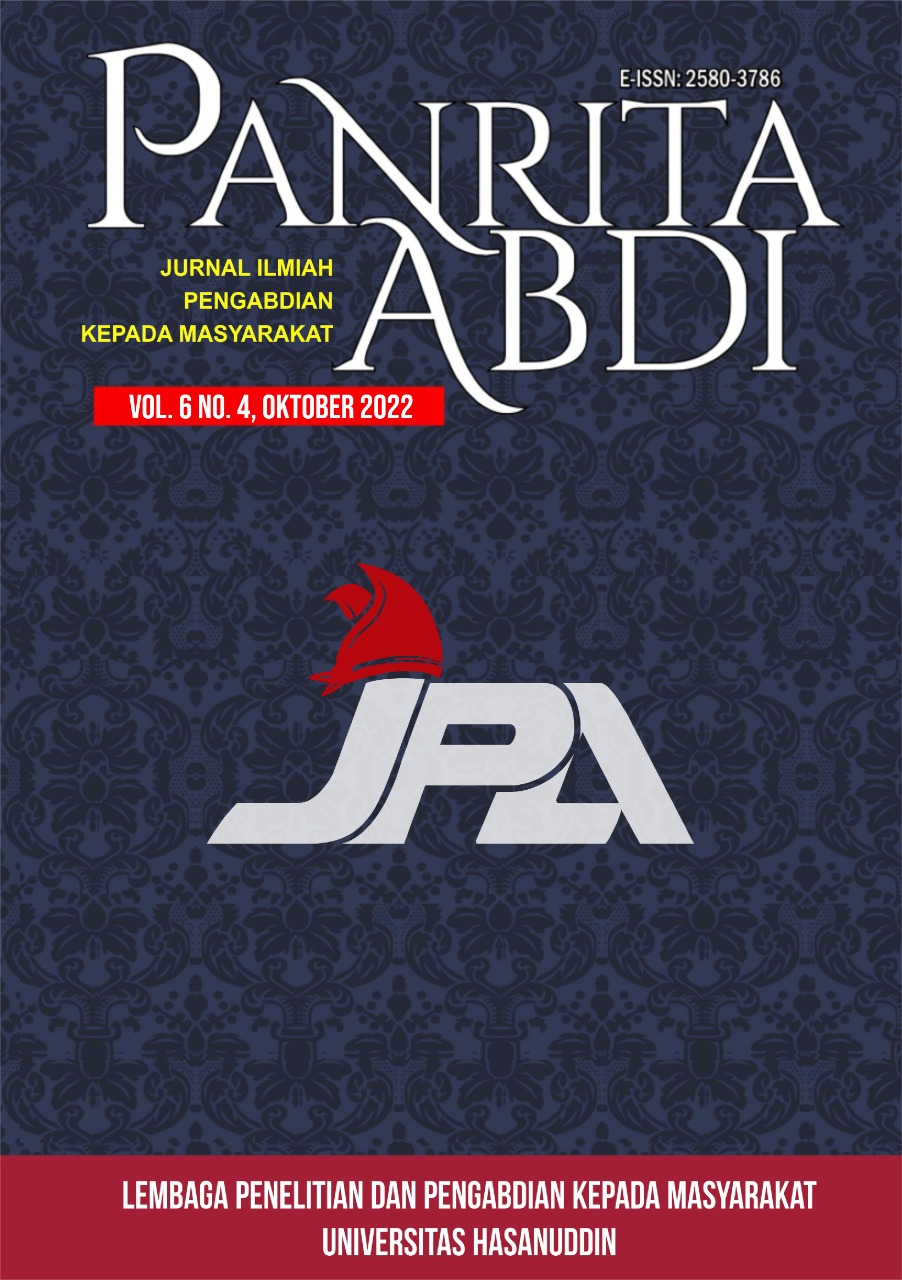PENINGKATAN KAPASITAS DENGAN PENERANGAN JALAN UMUM TENAGA SURYA BERBASIS ICT DI DESA NGENI
DOI:
https://doi.org/10.20956/pa.v6i4.18122Keywords:
Public street lighting, ICT, NgeniAbstract
The Ngeni Village community is a productive economic community with various sources of income. However, in this village, there are still fundamental problems. The main problem is accessing clean water and the lack of public street lighting. Two aspects of the problem in the community service activities have been carried out. The first aspect is about access to clean water, and this activity was implemented in 2020. The second aspect is the lack of public street lighting on the streets of Ngeni Village. Therefore, the service team has implemented appropriate science and technology to be utilized by the community, namely making solar street lighting. The purpose of this service activity is to build solar-powered public street lighting and provide ICT technology skills training so that people can be skilled in using ICT technology for their daily needs. The transfer of appropriate technology knowledge given to the community is hoped that the community can make their solar street lighting independently and can carry out maintenance independently in the future. The method applied in this activity is the Quantitative Method Approach, which emphasizes the in-depth understanding of a problem and is assisted by in-depth analysis techniques. The result of this activity is that 87 people attended the training well, and 20 expert teams succeeded and are skilled in advanced training by utilizing ICT technology as an alternative to solar-powered street lighting (PJU) at night. --- Masyarakat Desa Ngeni adalah masyarakat ekonomi produktif dengan berbagai sumber pendapatan yang dicapai. Akan tetapi, di Desa ini masih terdapat permasalahan yang mendasar. Masalah utamanya adalah sulitnya akses air bersih dan minimnya penerangan jalan umum. Terdapat dua aspek permasalahan dalam kegiatan pengabdian masyarakat yang telah dilakukan. Aspek pertama adalah tentang akses air bersih dan kegiatan ini telah di implementasikan pada 2020. Aspek kedua adalah minimnya penerangan jalan umum di jalan-jalan Desa Ngeni. Oleh karena itu, tim pengabdi telah menerapkan IPTEK yang tepat guna sehingga dapat dimanfaatkan oleh masyarakat dengan maksimal, yakni membuat penerangan jalan umum tenaga surya. Tujuan dari kegiatan pengabdian ini adalah melakukan pembangunan penerangan jalan umum bertenaga surya serta memberikan pelatihan keterampilan teknologi ICT sehingga masyarakat dapat terampil dalam pemanfaatan teknologi ICT untuk kebutuhan sehari-hari. Transfer ilmu teknologi tepat guna yang diberikan ke masyarakat harapannya agar masyarakat dapat membuat penerangan jalan umum tenaga surya sendiri secara swadaya dan dapat melakukan maintenance secara mandiri di masa depan. Metode yang diterapkan dalam kegiatan ini adalah Pendekatan Metode Kuantitatif dengan menekankan pada aspek pemahaman secara mendalam terhadap suatu masalah yang dibantu dengan teknik analisis mendalam (in-depth analysis). Hasil dari kegiatan ini adalah sejumlah 87 msyarakat mengikuti pelatihan dengan baik dan 20 tim ahli telah berhasil dan terampil dalam pelatihan lanjutan dengan memanfaatkan teknologi ICT sebagai alternatif penerangan jalan umum (PJU) bertenaga surya pada malam hari.Downloads
References
Bos, P., Helstynova, B., Baleja, R., Sokansky, K., & Novak, T. (2016). Suggestion of the methodology for verifying the outputs of different measuring groups evaluating light parameters of public lighting. Proceedings - 2016 17th International Scientific Conference on Electric Power Engineering, EPE 2016, 3–6. https://doi.org/10.1109/EPE.2016.7521762
Gunawan, E., & Wahyono, E. (2017). Jalan Umum Dengan Sistem Kontaktor. Jalan Umum Dengan Sistem Kontaktor, 1(1), 36–44.
Hikmawan, S. R., & Suprayitno, E. A. (2018). Rancang Bangun Lampu Penerangan Jalan Umum (Pju) Menggunakan Solar Panel Berbasis Android (Aplikasi Di Jalan Parkiran Kampus 2 Umsida). Elinvo (Electronics, Informatics, and Vocational Education), 3(1), 9–17. https://doi.org/10.21831/elinvo.v3i1.15343
Kalaimathi, B., Charumathi V, S., Annie Prasanna, M., & Aishwarya, T. (2021). Efficient Power Generation to Automated Street Lights based on Traffic Density. Proceedings - 5th International Conference on Computing Methodologies and Communication, ICCMC 2021, Iccmc, 1006–1010. https://doi.org/10.1109/ICCMC51019.2021.9418389
Mehdi, L., Hayar, A., Benjamin Sendama, N., Kheddioui, E. M. K., & Zazoui, M. (2017). Public street-lamps autonomy increasing based on self-lighting concept. Proceedings of 2016 International Conference on Electrical Sciences and Technologies in Maghreb, CISTEM 2016. https://doi.org/10.1109/CISTEM.2016.8066790
Mulyana, E., Setiawan, A. E., Sumaryo, S., & Munir, A. (2019). Data Monitoring System of Solar Module with Data Logger for Public Street Lighting Application. 2019 26th International Conference on Telecommunications, ICT 2019, 280–283. https://doi.org/10.1109/ICT.2019.8798777
Pachamanov, A., & Kassev, K. (2019). Rehabilitation and Remote Control of Municipalities Street Lighting. 2019 2nd Balkan Junior Conference on Lighting, Balkan Light Junior 2019 - Proceedings, 1–4. https://doi.org/10.1109/BLJ.2019.8883673
Shamin, N. & Demak N. A. K. (2018). Evaluasi Tingkat Penerangan Jalan Umum (PJU) di Kota Gorontalo. Sekolah Tinggi Teknik (STITEK) Bina Taruna Gorontalo, 7(1), 44–61.
Soppeng, K. (2018). Studi perencanaan instalasi penerangnan jalan umum (pju) menggunakan panel surya di desa pesse kecamatan donri donri kabupaten soppeng.
Szalai, A., Szabo, T., Horvath, P., Timar, A., & Poppe, A. (2016). Smart SSL: Application of IoT/CPS design platforms in LED-based street-lighting luminaires. Proceedings of 2016 IEEE Lighting Conference of the Visegrad Countries, Lumen V4 2016. https://doi.org/10.1109/LUMENV.2016.7745518
Tripathy, A. K., Mishra, A. K., & Das, T. K. (2018). Smart lighting: Intelligent and weather adaptive lighting in street lights using IOT. 2017 International Conference on Intelligent Computing, Instrumentation and Control Technologies, ICICICT 2017, 2018-Janua, 1236–1239. https://doi.org/10.1109/ICICICT1.2017.8342746
Downloads
Published
How to Cite
Issue
Section
License
Copyright (c) 2022 Lora Khaula Amifia, Dimas Adiputra, Isa Hafidz, Khodijah Amiroh, Ardiansyah Al Farouq, Ardiansyah Al Farouq, Robin Addwiyansyah Alfaro Samrat, Aditya Yudhistira, Ahmad Habibi

This work is licensed under a Creative Commons Attribution-NonCommercial-NoDerivatives 4.0 International License.



















